“It was right after I graduated high school and started farming. One day, I noticed moss growing on the roof of our house. Even under the blazing sun, it was quietly and firmly thriving. For me, that small sight left a surprisingly deep impression.”- Jaehong Park, CEO of Code of Nature
I had always thought moss only grew in damp and shaded places. But there it was, enduring the heat of the midday sun, holding its ground in silence.From that day on, COFN began to see moss in a new light. A plant we had passed by without notice suddenly felt like something more. What if recovery doesn’t begin with the loud and the large, but with something small, persistent and resilient? That is how moss became the starting point of Code of Nature’s journey toward ecological restoration.
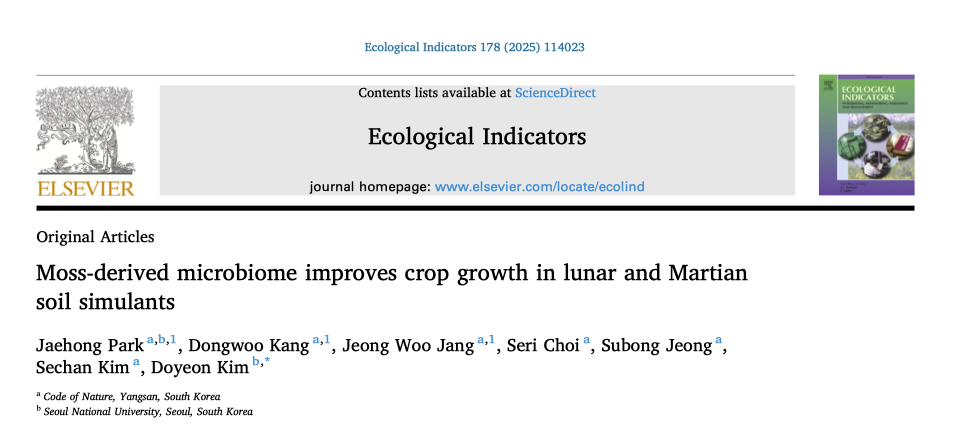
©Park, J., Kang, D., Jang, J.W., Choi, S., Jeong, S., Kim, S. & Kim, D., 2025. Moss-derived microbiome improves crop growth in lunar and Martian soil simulants. Ecological Indicators, 178, p.114023. https://doi.org/10.1016/j.ecolind.2025.114023
As we began to see moss with new eyes, we soon encountered a remarkable truth: moss is among the first plants to ever appear on land. When thinking of Earth’s early history, most people imagine the Jurassic or Cretaceous periods. But there is a much earlier time called the Precambrian era, when even the concept of nature barely existed. There were no forests, no grasses, and not even soil as we know it.During this barren time, the first lifeforms made their way onto land. They were part of a group of plants known as bryophytes, the ancestors of modern mosses. These plants had no roots or vascular systems, but they were the first to adapt to life on land. They made the beginning of ecosystems possible. Moss is not just an ancient plant. It was the key that opened the door to life on land.
이끼는 4억 년 전부터 지구에 존재해온 원시적 식물로, 관다발이 없어도 극한 환경에서 살아남았습니다.
· 수분 조절: 이끼는 토양의 수분을 붙잡아 건조한 환경에서도 미세한 수분 순환을 유지합니다.
· 토양 안정화: 입자를 엮어 침식을 막고, 물리적 구조를 강화합니다.
· 생태계 연결: 공생 미생물과 함께 영양분을 공급하며, 질소·탄소 순환을 촉진합니다.
즉, 이끼는 단순한 피복식물이 아니라 생태계 회복의 촉매제입니다.
달과 화성에 인간이 장기간 머물기 위해서는 단순한 탐사 그 이상이 필요합니다. 식량·산소·물과 같은 생명 유지 자원을 어떻게 자급자족할 지가 핵심 과제죠. 이를 위해 과학자들은 두 가지 개념에 주목합니다.
· BLSS (Bio-regenerative Life Support Systems, 생물 재생형 생명 유지 시스템) : 식물·미생물 같은 생물학적 시스템을 이용해 자원을 순환적으로 공급하는 방식
· ISRU (In-Situ Resource Utilization, 현장 자원 활용) : 지구에서 모든 자원을 가져오는 대신, 달과 화성 현지 자원을 최대한 활용하는 방식
최근 연구에서는 장기 우주 임무나 달·화성 거주지에서 모든 식량을 지구에서 보급하는 것은 물류·비용·시간 면에서 비현실적이라는 지적이 제기되고 있습니다. 따라서 현지 자급 시스템 구축은 우주 개발 단계에서 필수 과제가 되고 있습니다. 그러나 실제 달·화성 토양은 작물 재배에 여러 한계가 있습니다.
· 달·화성 모사토: 필수 영양소 부족 → 비료/유기물 없이는 작물 생산 어려움.
· 화성 모사토: 낮은 유기물 함량, 높은 염분, 중금속 농도 → 식물 생장에 부적합.
이런 제약 때문에, 현지 토양을 개선하고 작물 재배를 가능하게 하는 새로운 해법이 필요했습니다. 바로 그 해답을 찾기 위해 이번 이끼-미생물 복합 연구가 설계된 것입니다.
연구팀은 건조 분말 상태의 H. plumaeforme와 이끼에서 분리한 미생물(P. monteilii, B. cereus 등)을 활용했고, 시험 작물은 보리(H. vulgare)를 선택했습니다. 보리는 발아 속도가 빠르고 환경 적응력이 높아, 지구와 우주 양쪽에서 식량 자원으로 적합하기 때문입니다.
특히 이번 실험은 국제적으로 검증된 달 모사토(LHS)와 화성 모사토(MGS)를 활용했습니다. 이 두 토양은 NASA와 국제 연구 기관에서도 표준으로 사용하는 공인 모의 토양(simulant)으로, 실제 달·화성 토양의 물리·화학적 특성을 충실히 반영합니다.
실험 설계는 다음과 같습니다.
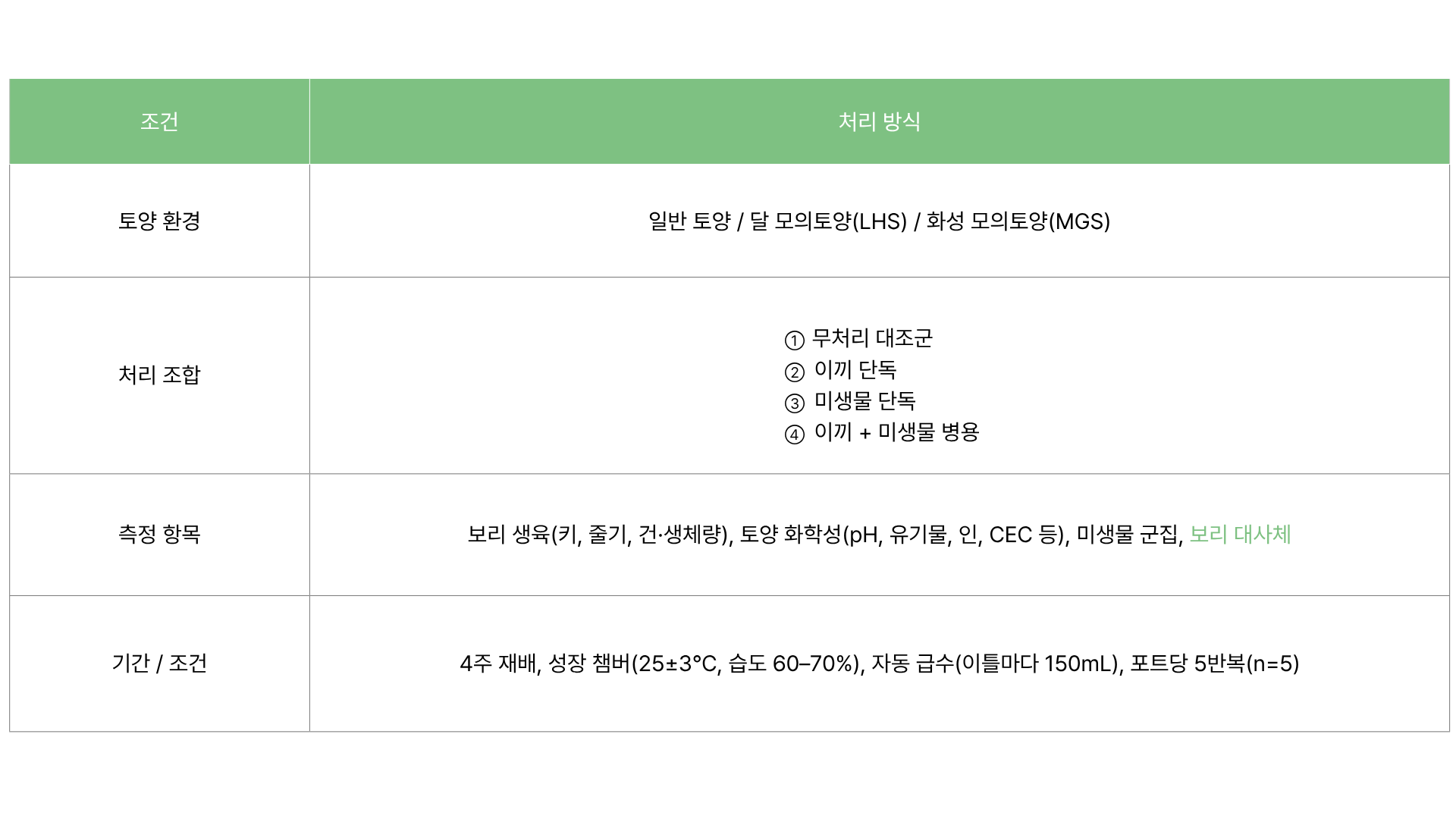
Moss is typically only 1 to 10 centimeters tall, but within its small form lies a survival strategy that has endured for hundreds of millions of years. Moss can live without putting down roots. It survives using only the moisture it absorbs, which powers its photosynthesis and metabolism. This is why it can thrive even in places without soil. While moss usually prefers cool and shaded environments, it can also survive in much harsher conditions. At the heart of this resilience is a physiological trait called Desiccation tolerance*. Thanks to this ability, moss has been found surviving under Antarctic ice, between rocks in deserts, and even in outer space during scientific experiments.
1. 일반 토양
· 이끼 처리만으로도 보리의 줄기 성장과 생체량 증가.
· 비교적 비옥한 환경에서도 이끼가 수분·양분 순환을 개선.
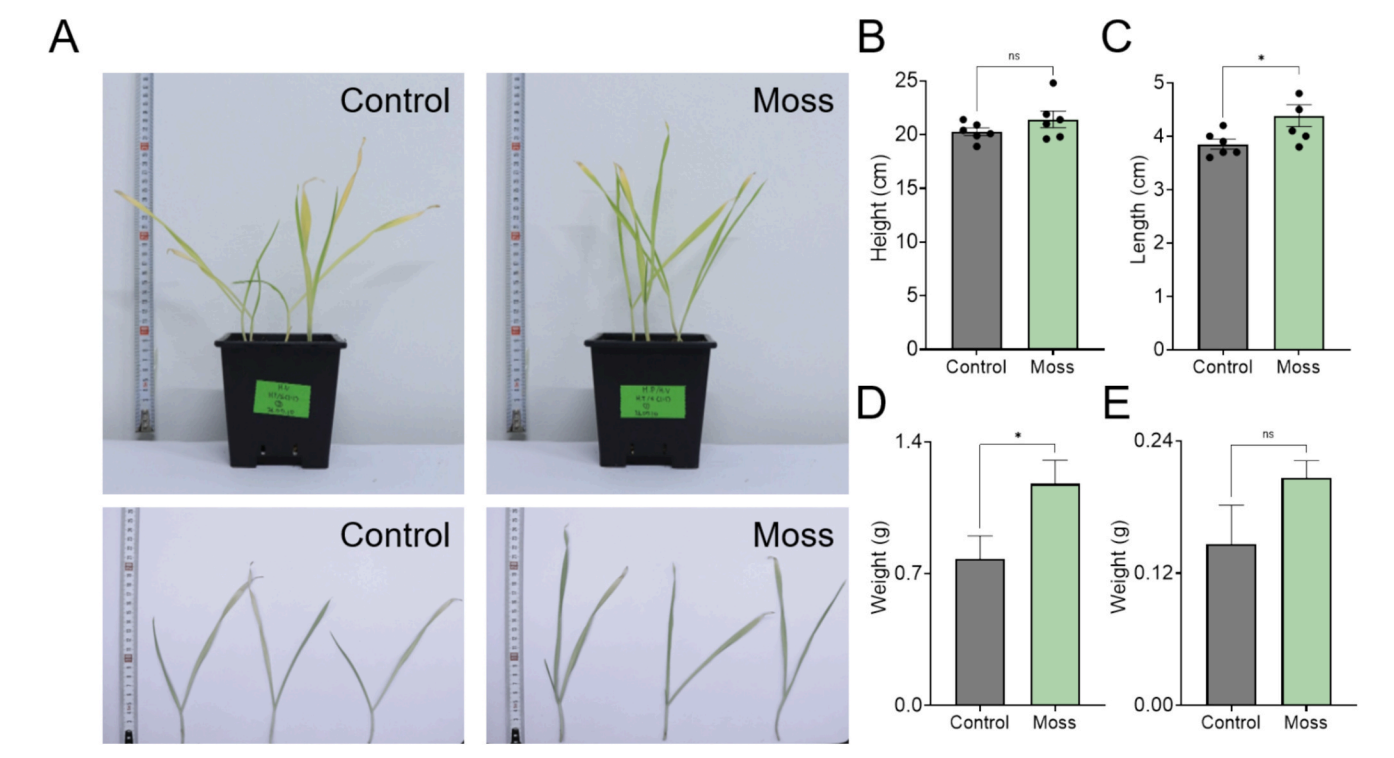
대조군(Control)과 이끼 처리한 토양(Moss)에서 자란 보리의 모습
2. 달 모의 토양 (LHS)
· 보리 키·줄기 길이·건중량 모두 크게 증가.
· 이끼+미생물 병용에서 가장 뚜렷한 상승 효과(additive effect) 확인
3. 화성 모의 토양 (MGS)
· 이끼 처리만으로도 보리의 생장 지표 개선.
· 그러나 미생물 단독 효과는 제한적, 이끼와 병용했을 때만 성장 회복이 나타남.
· 이끼가 미생물 정착을 돕는 생물학적 완충제로 작용.
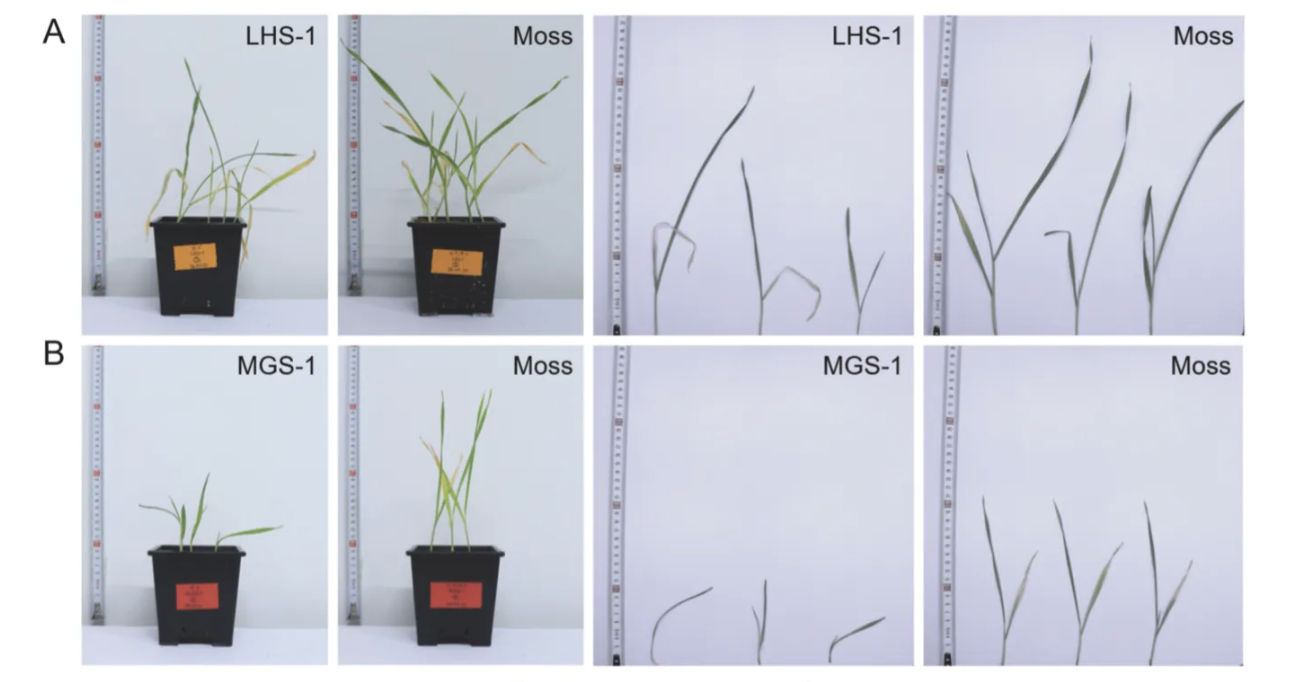
달 모의 토양(LHS)와 화성 모의 토양(MGS)에서 자란 보리의 모습
4. 미생물·대사체 분석
· 이끼 처리 토양에서 Pseudomonas, Bacillus, Devosia 등 유익균 우세화
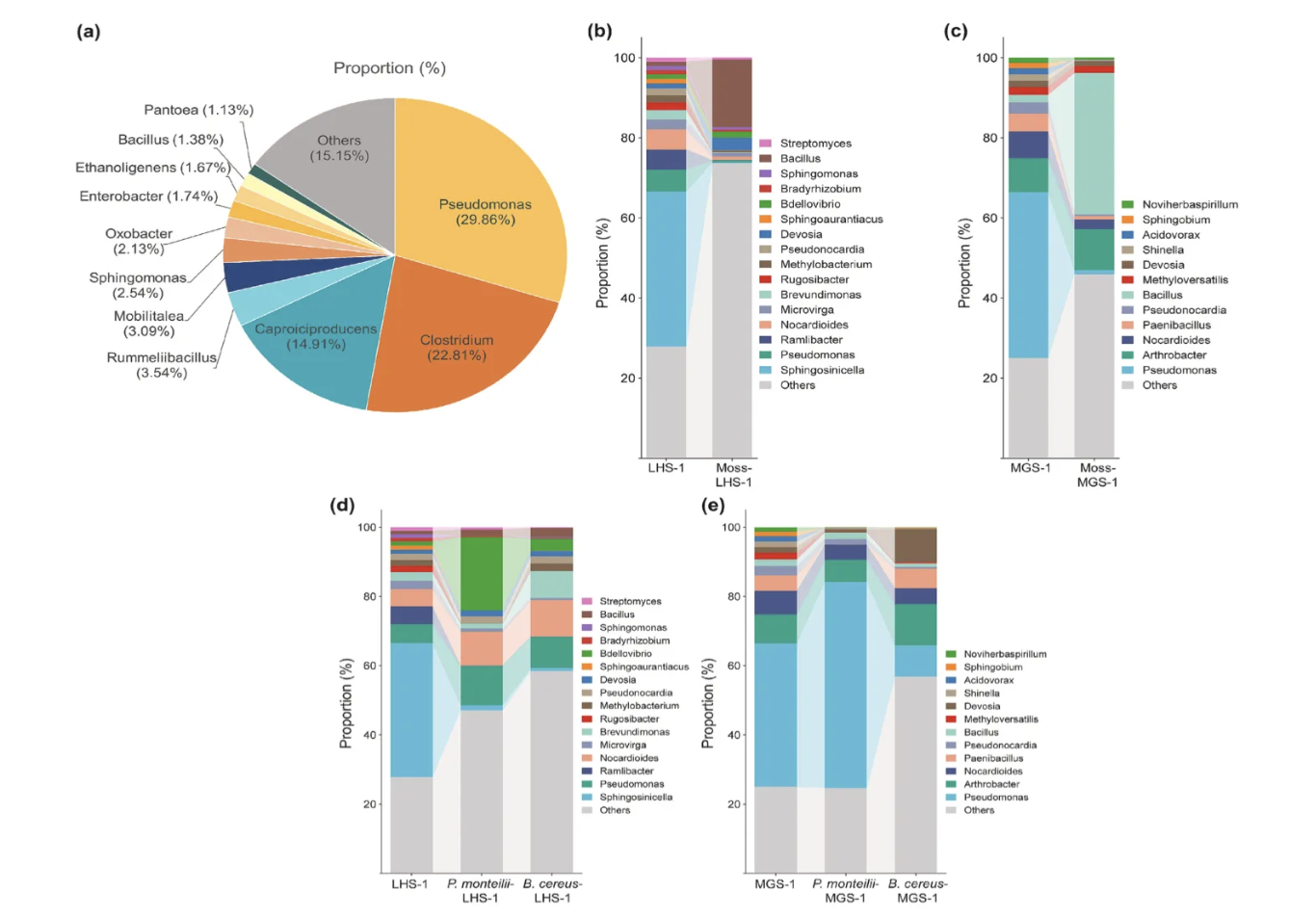
미생물 군집 분석
· 대사체 분석 결과, 모든 조건에서 D-ribose, D-gluconate 증가 → 핵산 합성과 환원 대사 활성화 → 세포 분열·생체량 축적 촉진
· 특히 MGS에서는 UDP, L-cystine도 증가, 스트레스 방어·산화환원 균형 조절 신호로 작용
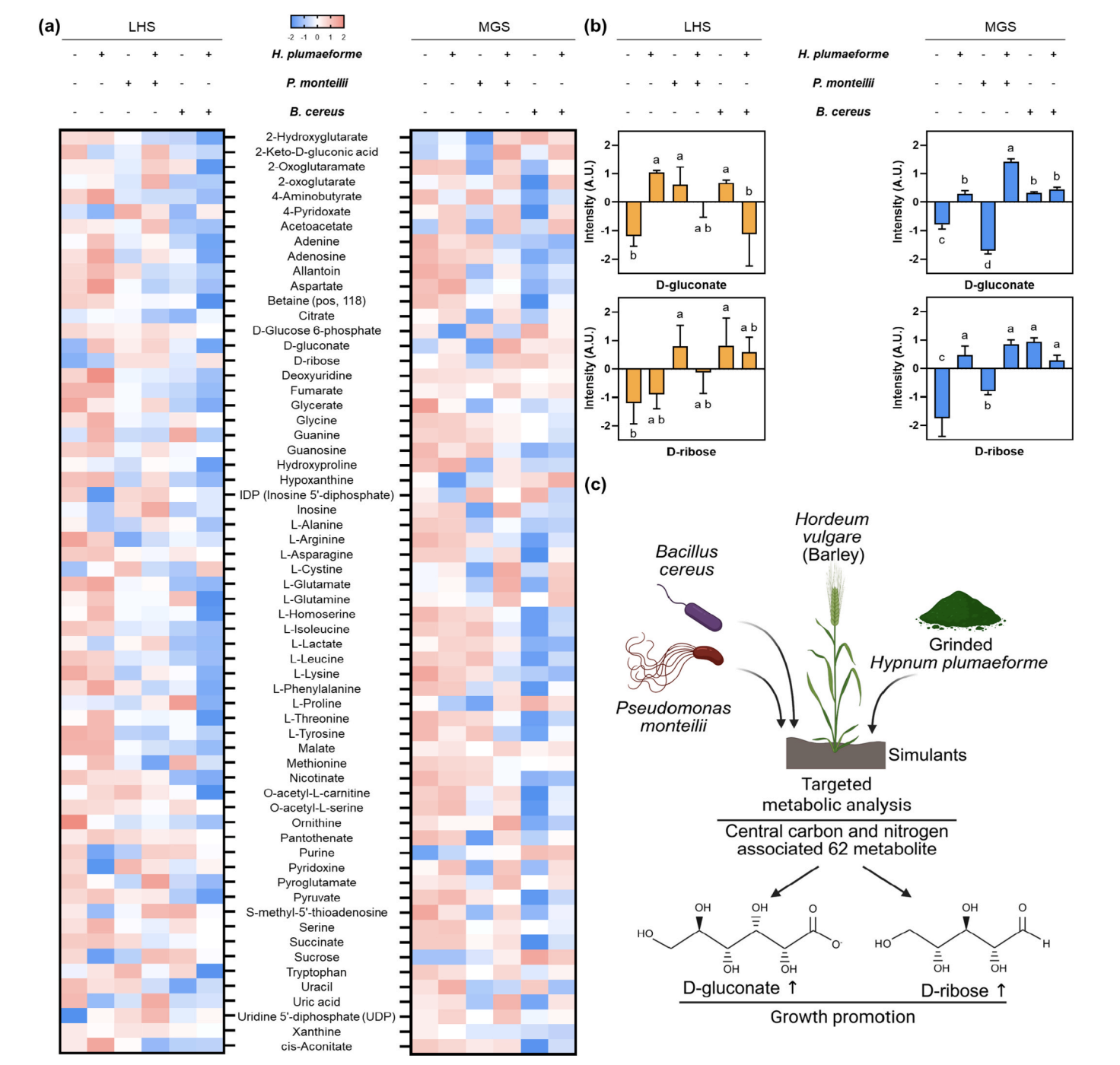
미생물 대사체 분석 결과
· 이끼는 단순히 물리적 효과만이 아니라, 토양 미생물 군집을 조절하여 식물 성장 촉진에 중요한 역할을 함.
· 특히 Pseudomonas, Bacillus 등 식물 성장 촉진균(PGPR)이 핵심 기여함.
Now the answer is clear. Moss quietly builds foundations where no one sees, creating the conditions for other life to grow. Inspired by this, COFN designs the groundwork for ecological restoration.That is why we chose moss.We create the foundation that allows nature to heal itself. Restoration is not just about bringing back something green. It requires clear standards and measurable progress. That is why our most important mission is to make restoration something that can be quantified and understood. At COFN, recovery is not a vague slogan. It is a change proven through data.
Every day, we design nature-based solutions grounded in this philosophy. COFN prepares environments where new life can take root in places that have been left barren.
The beginning of recovery is always small and quiet. But in the end, it always leads to new hope.
이 연구는 네 가지 층위에서 중요한 함의를 지닙니다.
1. 이끼-미생물 상호작용 규명 : 이끼는 공생 미생물의 활성을 높여 토양 내 유효 인산 등 영양분을 늘리고, 식물 생장에 유효한 대사체까지 생성하게 함으로써 보리의 성장을 촉진했습니다.
2. 생태 복원: 황폐화된 지구 토양을 회복할 수 있는 자연 기반 솔루션을 제시했습니다.
3. 농업 혁신: 화학 비료 의존도를 줄이고, 지속가능한 작물 생산을 실현할 수 있는 친환경 바이오 비료 전략 가능성을 보여주었습니다.
4. 우주 농업: 이번 연구는 BLSS와 ISRU가 직면한 한계를 보완하며, 우주 내 식량 자급자족 시스템을 실현 가능한 방향으로 확장했습니다.
이끼와 미생물의 상호작용은 황폐화된 지구의 토양을 되살리고, 나아가 인류의 우주 확장까지 준비시키고 있습니다.
코드오브네이처는 종종 “왜 하필 이끼인가?”라는 질문을 받습니다.
이번 연구는 그 질문에 과학적 근거로 답을 줍니다.
· 이끼는 토양을 살리고, 미생물이 정착할 수 있는 기반을 마련하는 생태계의 출발점입니다.
· COFN이 집중하는 균주(COFN005, COFN006) 역시 Pseudomonas, Bacillus 계열과 마찬가지로 토양 회복·작물 성장의 핵심 파트너입니다.
· 제주 오름 복원 프로젝트와 같은 현장 사례는 이번 연구 결과를 실제 생태계 회복 전략과 연결합니다.
작은 이끼가 거대한 생태계를 회복시킬 수 있다는 믿음, 그것이 코드오브네이처가 이끼에 집착하는 이유입니다.